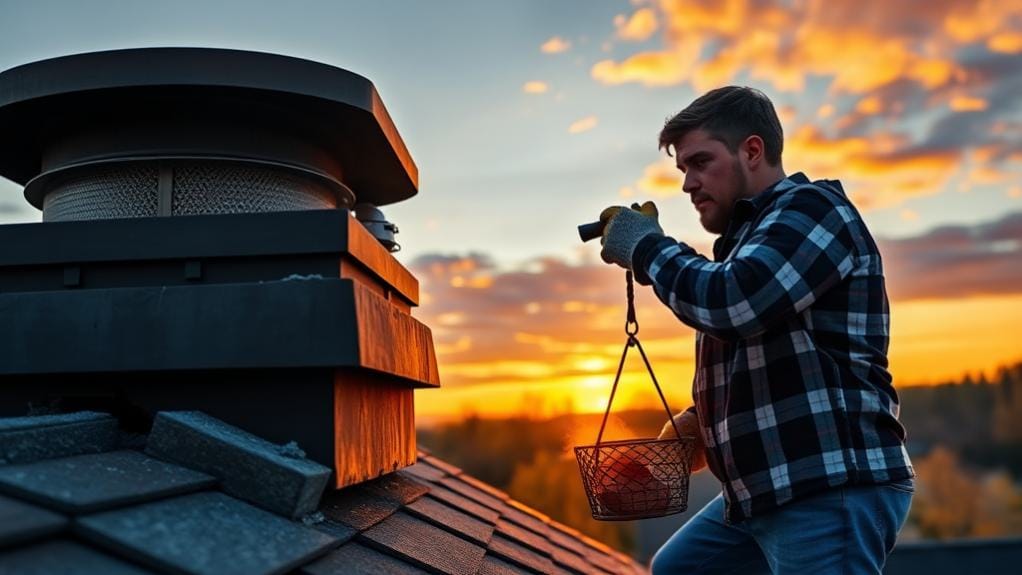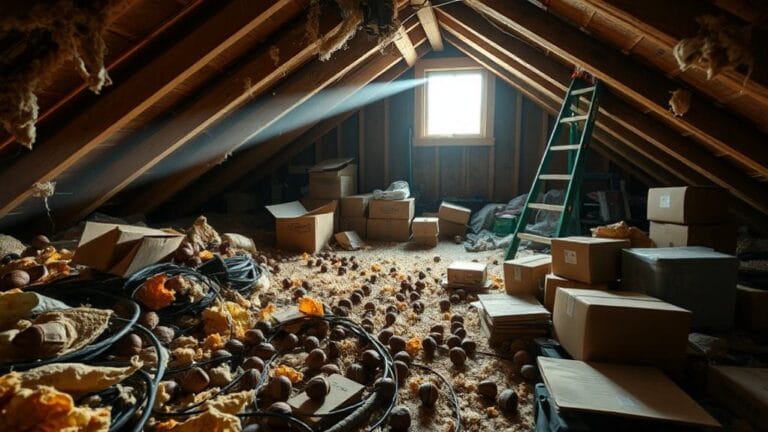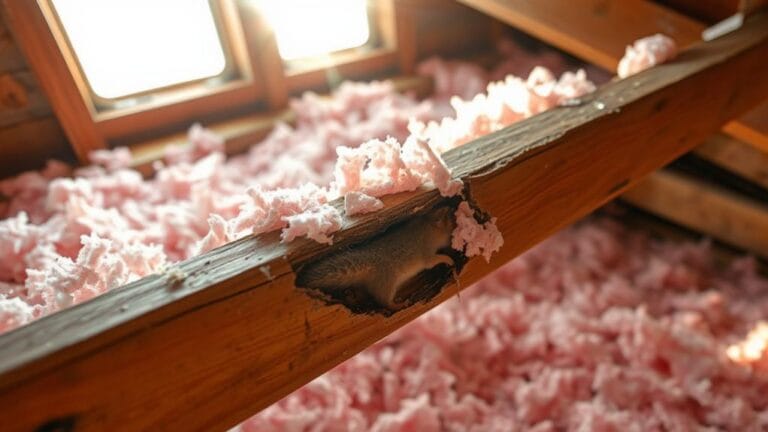Got a squirrel stuck in your chimney? Don't panic – and definitely don't light a fire. First, close your damper to prevent an unwanted houseguest. Then try hanging a thick rope down the chimney as an escape route, or create some noise with pots and pans to encourage them upward. If that fails, set up a live trap with peanut butter in the fireplace. Still stuck? Time to call wildlife removal pros who handle these furry predicaments daily. Whatever you do, don't use smoke or fire to force them out – that's just cruel and dangerous. Once they're gone, install a chimney cap to prevent round two of this adventure.
Assess the Situation First
Table of Contents
Before taking any action, carefully evaluate the squirrel's predicament in your chimney.
You'll need to assess the situation thoroughly – and yes, that means playing detective with your chimney space. Understanding their complex communication system and behavior patterns will help you better gauge their state of distress.
Start by listening for those telltale scratching sounds. Trust me, a squirrel stuck in there isn't going to be quiet about it.
Check for access points around your chimney's exterior – you might discover why your unwanted guest picked your home for its mishap.
Quick assessment checklist:
- Inspect the chimney flue for signs of nesting materials (because sometimes it's not just a visit – it's a move-in)
- Observe the chimney entry from outside
- Make sure your fireplace damper is closed to prevent an unwanted indoor visit
- Look for structural issues that might've trapped our furry friend
*Pro tip: The more you know about the situation, the easier it'll be to get your squirrely tenant out.*
Create a Safe Escape Route
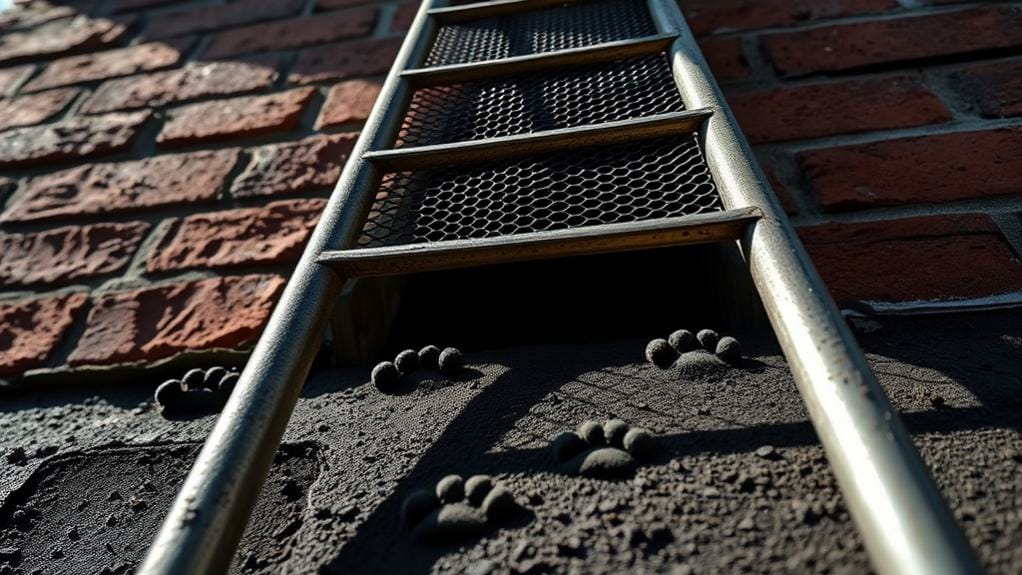
Once you've confirmed a squirrel's presence in your chimney, it's time to create their escape route. While humane capture methods like Havahart traps work well in other situations, a rope escape route is best for chimney scenarios.
The solution's actually pretty simple – hang a thick rope down your chimney flue. And we're not talking about that flimsy clothesline you've got in the garage. You'll need a rope that's at least 3/4" thick so your furry friend can get a good grip.
Whatever you do, don't try to smoke the squirrel out. (Yes, some people actually think that's a good idea.) Starting a fire will only terrify the poor creature and possibly kill it.
Instead:
- Secure the rope at the top of your chimney
- Let it dangle all the way down
- Check regularly to monitor the squirrel's progress
*Pro tip: Keep a chimney snare pole handy as backup, especially if you've got young squirrels up there.*
Use Sound to Guide Them
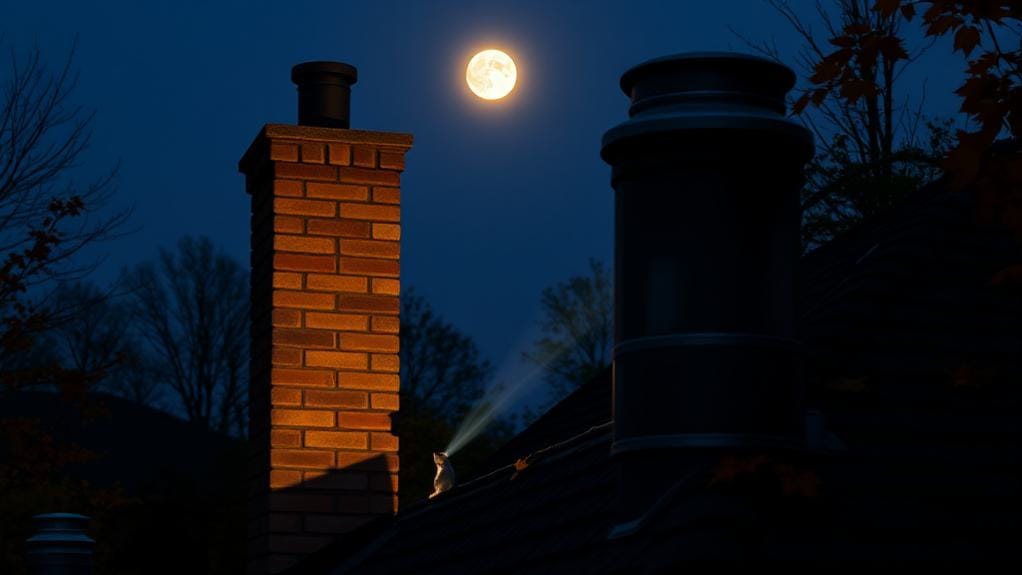
Sound serves as a powerful tool to guide your trapped visitor toward freedom. Keep your fireplace damper closed while you make noise – unless you want a panicked squirrel running through your living room!
Creating consistent background noise will help coax the squirrel toward the open flue and its escape route. Since squirrels build dreys for protection high in trees, they're naturally inclined to seek upward escape routes when stressed.
Here's your action plan to drive that stuck squirrel crazy (in a good way):
- Close all interior doors to contain the sound stimuli
- Bang pots and pans near the fireplace – yes, you'll look ridiculous, but it works
- Leave a radio playing near the chimney for background noise
- Make intermittent loud noises if you hear the squirrel moving around
*Pro tip: If your furry friend isn't budging, keep at it. Persistence is key when trying to navigate towards freedom – even squirrels eventually take a hint!*
Set Up a Live Trap
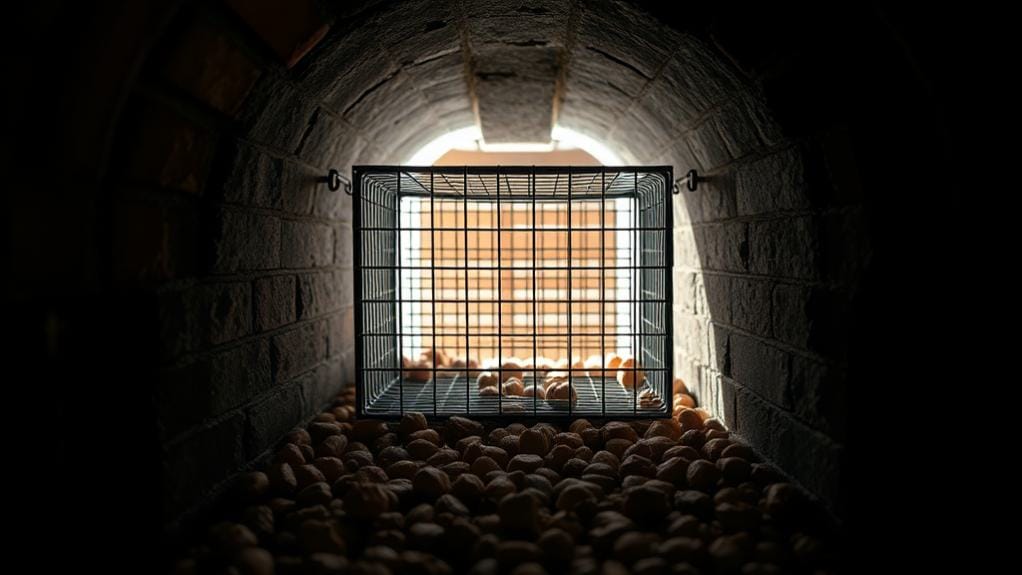
Live trapping offers a reliable solution when noise and other tactics haven't convinced your chimney squirrel to leave. To successfully capture your stubborn houseguest, you'll need to be strategic about the setup. Using weather-resistant bait paste specifically designed for trapping will increase your chances of success.
First, confine the animal by closing all interior doors. This isn't the time to give your unwanted visitor a grand house tour!
Next, open windows near the chimney to create a clear exit route for later. Trust me – you don't want a confused squirrel doing laps around your living room.
Place a live trap in your fireplace with some irresistible peanut butter as bait. Be quiet and careful – no sudden movements that'll spook your furry friend.
Once you've caught the stuck squirrel, release it several miles from your home. And no, your backyard doesn't count as "several miles away."
Install Emergency Rope Systems
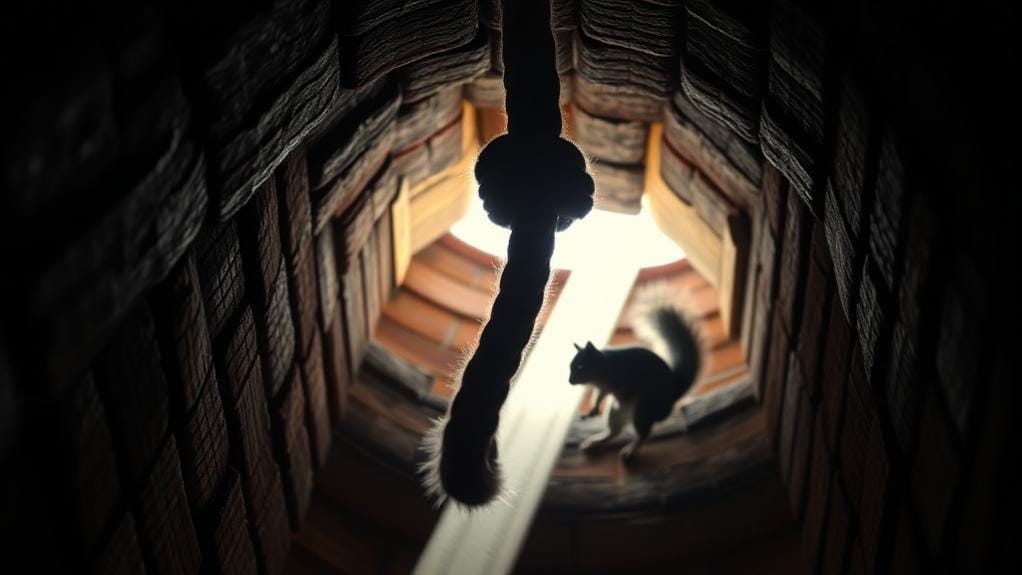
If your squirrel seems more scared than stuck, creating an emergency rope system might be your best solution.
You'll need a thick rope (3/4" or thicker) that's long enough to reach the bottom of your chimney flue. Since squirrels are excellent climbers and naturally seek high nesting locations of at least six meters up, a rope escape route aligns with their instincts.
This isn't rocket science, but it needs to be done right if you want that furry friend safely removed.
- Drop your thick rope down the flue and make sure it's securely anchored at the top.
- Create footholds by tying knots every 12-18 inches along the escape route.
- Check that the rope won't slip when the squirrel starts to climb out.
- Regularly check the setup until your stuck squirrel makes its great escape.
*Pro Tip: Skip the metal chains or slick materials – unless you're trying to create a squirrel slip-n-slide. Natural rope is your best bet for success.*
Contact Wildlife Removal Professionals
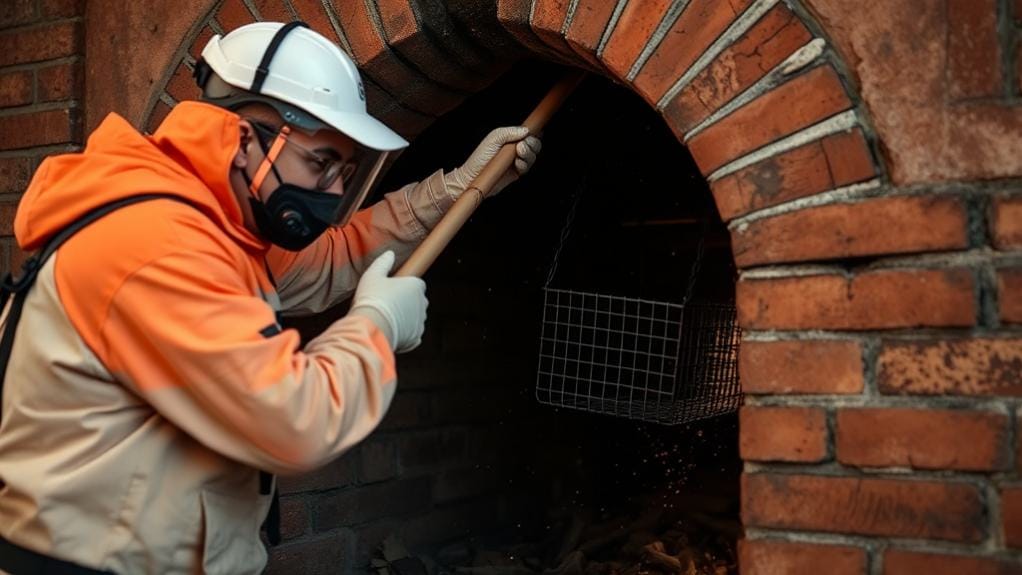
When you're up against a stubborn squirrel situation, professional wildlife removal experts should be your go-to solution.
These pros offer 24/7 service for freeing a stuck squirrel from your chimney – because wild animals don't exactly keep business hours.
You'll get immediate access to experts who know exactly how to remove the squirrel using humane trapping methods and specialized equipment.
They're pros at safe capture and won't turn your chimney into a squirrel war zone.
Pro Tip: If there are babies involved, don't play hero. Wildlife removal specialists know how to handle the whole family unit.
Best of all, they'll give you solid preventative advice to keep future furry visitors out.
From installing chimney caps to identifying potential entry points, they'll help you squirrel-proof your home for good.
Prevent Future Chimney Intrusions
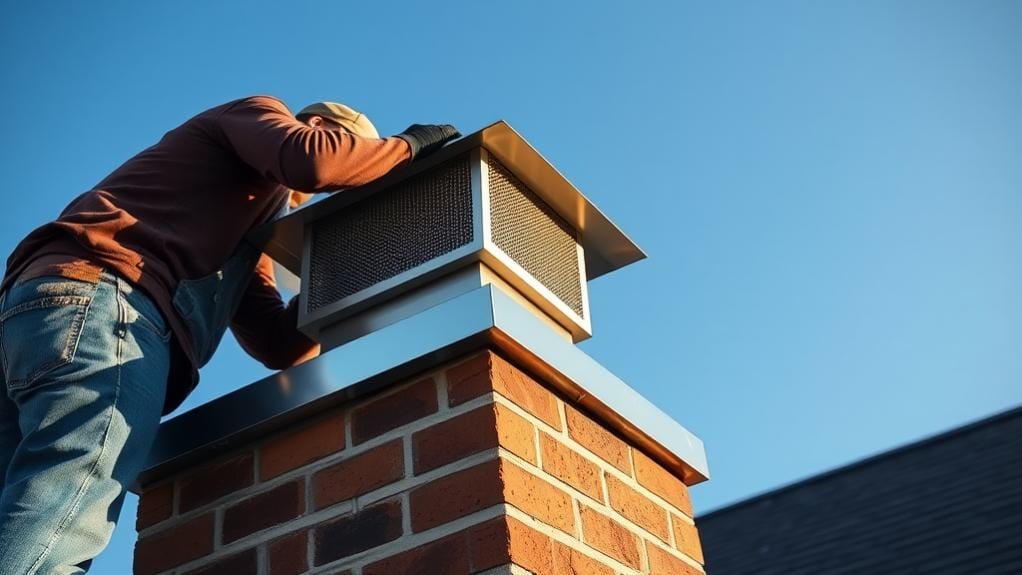
Once you've successfully evicted your unwanted chimney guest, taking preventive measures becomes essential to avoid future squirrel invasions.
Let's stop the problem before it starts – because honestly, who wants to keep getting rid of a squirrel from their chimney?
Here's your no-fail prevention plan:
- Install a sturdy steel chimney cap to prevent any wildlife from treating your chimney like their personal condo.
- Schedule regular semi-annual inspections to catch potential entry points before squirrels do.
- Keep the fireplace damper closed when not in use – it's like locking your front door, but for your chimney.
- Remove potential nesting materials from your yard and educate yourself on signs of squirrel activity.
*Pro Tip: Don't wait for scratching sounds to take action. Prevention is way easier than eviction!*
Frequently Asked Questions
How Long Can a Squirrel Survive if Trapped in a Chimney?
You'll find that trapped squirrels can survive 1-2 days without water and up to 8 days without food. However, they may die sooner from stress, exhaustion, or injury while trying to escape.
Will Homeowner's Insurance Cover Damage Caused by Trapped Squirrels?
Your homeowner's insurance typically won't cover squirrel damage unless you've got specific wild animal coverage. Check your policy details, as standard plans often exclude rodent-related destruction unless it's sudden and accidental.
Can Squirrels Transmit Diseases Through Chimney Ventilation Systems?
Though you can't see them, squirrels carry diseases like rabies and leptospirosis that could spread through your ventilation. You'll want to block access points and get your ducts cleaned to protect your family's health.
Should I Leave Food Near the Fireplace to Lure It Down?
Don't leave food near your fireplace – it'll likely attract other pests instead of helping the squirrel. You're better off calling animal control or using a rope to create an escape route downward.
What Time of Day Are Squirrels Most Active for Rescue Attempts?
You'll have the best chance to rescue squirrels during early morning or late afternoon when they're naturally most active. Don't attempt rescues at night since they'll be less responsive and harder to spot.
Last Word
You've now got the tools to handle a panicked squirrel in your chimney – but don't get cocky. Last winter, my neighbor ignored a trapped squirrel for days, thinking it'd find its way out. It didn't. The critter caused $2,000 in damage and left quite the "collection" behind those expensive brick walls. Act fast when you hear those first scratches. Your wallet (and nose) will thank you later. Prevention beats panic every time.

